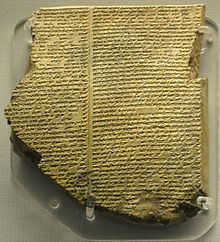Column set
Column set in letterpress printing refers to the set of a printing unit designed as a page . Whose single column (abbreviated Sp. ) Is called a column (from latin columna , column '), especially when in a closed multi-column set text comprises. Multi-column typesetting has been common for large-format books from the beginning of book printing and follows the example of large-format manuscripts in codex form.
History: columns in manuscripts

The distribution of text over several columns is about as old as literature. The standard version of the Akkadian Epic of Gilgamesh , as it is known from the library of Aššurbanipal , was written on blackboards with three columns of text in a fixed layout on the front and back.
Even Egyptian texts since the Old Kingdom often written in columns, with the vertical lines of text about the Pyramid Texts may serve as a model. For longer papyrus rolls , therefore, the arrangement of the text in columns was generally recommended. In papyrus, leather or parchment rolls , the arrangement of the text in columns remained the standard even after the invention of the alphabet when these became common for fonts that did not have vertical lines, such as the Hebrew or Greek script. Examples of the Dead Sea Scrolls include: B. the Hebrew temple scroll or the Greek scroll of the twelve prophets from Nachal Chever .

After the invention of the Codex, a multi-column layout was also chosen for large-format manuscripts for the sake of clarity. The Greek Codex Vaticanus , the oldest surviving full Bible, is largely written in three columns, the Codex Sinaiticus in four columns. Since the Greek script did not have any spaces between words at that time and the line ends did not have to coincide with the end of a word, a uniform appearance was possible even with relatively narrow columns. Also, Syrian and Hebrew Bibelkodizes such. B. the oldest known manuscript of the complete Hebrew Bible , the Codex of Aleppo , used a multi-column layout.
The first printed books were based on the appearance of the manuscripts of their time. The Latin Gutenberg Bible was set in two columns.
Use of the column
The column is a means of structuring the text. "The column may be the entire set or font mirror fill; but this can also be divided into several columns. "
Hence the name infers that the side in the block than at the edge marginal arranged columns the Kolumnentitel support as the page heading, and include the central, flowing the main text. You give the pages a uniform structure.
Multi-column sentence
There are different types of multiple columns . A continuous text can be set in columns (column set) , but also several texts or different text parts can be arranged in columns on one page (column set) . In principle, multi-column typesetting is usually carried out as a block type, always the same line length.
The book designer or typographer chooses the form of the arrangement with columns when the text parts relate to one another, e.g. B. Supplements, explanations and comments on the main text. This makes it easier to read and understand the text. Here the columns can have different widths and font sizes . This type of multiple columns is often found in scientific works, e.g. B. with legal texts.
The use of multiple columns in continuous text is often found in reference books , magazines, and newspapers . The advantage of the multi-column sentence as text design is that the line length is kept short, especially with large-format paper: Lines of 30 to 40 characters can be recorded without any particular eye movement, so the eye can run through the column vertically. Such narrow columns make high demands on the justification , but the types of publication mentioned are not very demanding in terms of typeface .
In the modern, electronically implemented layout , the sentence in several columns poses special problems, since the break ( column break ) - traditionally referred to as mettage - can no longer be handled with simple control characters such as line break and page break : the continuous text must be changed from one to the next column, and only from the last column of the page to the first column of the next page. There are also the more complex problems of the columnar sentence, in which a column is reserved for another text and has to be excluded from the break, or even only a half-column, half the height of a column.
Column set is now mostly integrated in the main features of office packages for desktop publishing , which are also available for end users .
Column set on the web
With CSS3 it is possible to display the text of an HTML page in two or more columns.
See also
- Type area
- Typography , book design
- Column , the journalistic miniature form derived from the column sentence
literature
- Helmut Hiller, Stephan Füssel: Dictionary of the book . 6th edition. Vittorio Klostermann, Frankfurt am Main 2002. ISBN 3-465-032209
- Reclams non-fiction dictionary of the book . Edited by U. Rautenberg. 2nd, improved edition. Reclam-Verlag, Stuttgart 2003. ISBN 3-15-010542-0
Individual evidence
- ^ TU Dortmund: Formalia scientific work .
- ^ Rautenberg (n.d.), Reclams Sachlexikon des Buches , Reclam, n.d., p. 303.
- ↑ Information page of W3SCHOOLS.com on column-count - accessed April 8, 2015.
